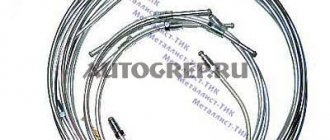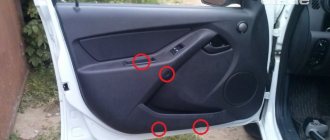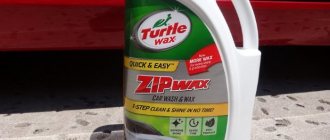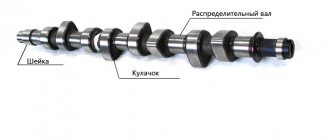Hello dear readers of the kuzov.info blog!
This review article will tell you about the types of car waxes, their application, advantages and disadvantages.
There are hundreds of wax-based products available today. They can be divided into the following categories:
- Liquid waxes
- Waxes in paste form
- Wax sprays
- Sealants for body protection (sealants)
For some car enthusiasts, waxing a car is a huge pleasure. Thus, they seem to achieve perfection in the appearance of the car. They are ready to polish the body every day. Such people are willing to spend a lot of time waxing, using products that are applied in several stages.
For other people who value their time very much, but at the same time want their car to be well-maintained, they need a simple and quick solution to restore the shine and protect the body. For both categories of people, there are products that can give excellent results. Let's look at the preparation and waxing process.
You need to start by cleaning the surface
Before applying any protective waxes, the car body must be washed. Simply washing the body will not be enough; ingrained dirt and stuck solid particles remain on the surface. For more thorough cleaning after washing, universal cleaning waxes, cleaning clays and other compounds are used. Let's take a closer look at the advantages and disadvantages of these cleaning methods.
The reason Turtle Wax 2in1 waxes have been so popular is because they are both a cleaner and a waxing product. Many people now use a synthetic cleaning clay first and then apply wax to the clean paint.
Wax composition 2in1 (cleaner and protection wax) vs cleaning clay + wax
Most modern cars have a clear coat, even if the paint is not metallic. This coating differs from coatings without varnish. Modern varnish coatings are applied in a thin layer. This is done in order to save money and reduce the final cost of the car. Thus, it is not correct to regularly use abrasive products to clean and polish the body. 2in1 wax compounds are both wax-based cleaners and polishing compounds. As cleaners they contain abrasive particles. The reserve thickness of the varnish will not allow you to do a lot of abrasive polishing. It is advisable to use cleansing clay and then use wax that does not contain cleaners. You can read more about using cleansing clay here.
Polish to remove imperfections...before waxing
If the car you are going to wax has minor scratches and abrasions, then you first need to apply abrasive polishing. Some people mistakenly believe that applying wax will remove minor defects. Before applying wax, you need to remove small scratches, traces of dried water, and abrasions. All this can be eliminated or smoothed with abrasive polishing. Wax will simply preserve the cleaned and restored surface.
Wax removal
If the service life of the car wax has expired, but its remains remain on the body, they should be removed before renewing the layer.
Clay or cleaning sprays are used for removal. The products are applied to the body, wait a while, after which the body is wiped with rags or towels.
It is prohibited to use detergents for such purposes.
Applying car wax using a spray
Spray wax can be considered the easiest way to apply wax protection. Spray wax now rivals the best liquid and paste waxes. Wax sprays use polymers that provide good protection.
Many polymer spray-on protective coatings can be applied even in open sun. Of course, for best results it is better to use them in the shade. For example, Meguiar's Ultimate Quik Wax (spray wax) can provide the same level of protection as Meguiar's NXT Generation Tech Wax.
To apply spray wax, you must first thoroughly wash your car. Next, you need to prepare a special microfiber towel for polishing. You need to apply the wax and immediately rub it with this towel. Thus, it is better to treat the surface in small segments. After treating the entire panel, you need to turn the towel over and, using the clean side, you need to finally polish the entire surface again. This way you will evenly distribute the applied protective composition.
Question #1: How often should I wax my car?
It is recommended to carry out the procedure of applying it to the car at least twice a year. Once in the fall to provide the car with a protective layer from road salt and dirt. And once in the spring - to update the layer.
See also: How to clean the engine compartment so that it shines
According to other sources (most likely, they will tell you this at the car wash), it is necessary to update the layer after every fourth or fifth wash.
Both options are working and have a right to exist. We will explain why this is so below.
Application of liquid wax and paste wax
In the past, paste waxes were the most preferred as they gave good results. Nowadays, many manufacturers offer liquid and paste versions of wax, which have the same composition. What is their difference? It all depends on preference and application method. Many people find that paste waxes are more suitable for hand-polishing, while liquid waxes are more suitable for use with a polisher.
There is no need to overdo it with the amount of wax applied. This applies to both paste and liquid wax. Less is better. You should get a uniform thin wax layer. For modern polymer waxes, a thick layer is not necessary. A thin layer dries faster and is easier to rub.
When applying liquid and paste waxes, follow these instructions::
- Treat the surface in the shade, where there is no direct sunlight.
- Use a special applicator recommended by the manufacturer or available with wax. A foam sponge is usually suitable.
- Treat body panels in segments of 20 - 40 square centimeters. Some products can be applied to the entire car before rubbing.
- You need to check in the instructions for the product you are using whether you need to wait for the wax to dry before rubbing it. Some products require drying before rubbing, and some need to be rubbed in immediately after application.
- Always use a small amount of rubbing wax. Using too much wax will only waste it. If you apply a lot of wax and it doesn't rub well, try switching sides of the microfiber towel and repeat rubbing with the clean side.
After waxing, the surface should be smooth and shiny, without streaks or smudges of wax.
What to do if, after all the work done, you still have streaks and areas where the wax is difficult to rub. There are several techniques for this. The simplest one is to park the car under the sun for 10–15 minutes. The wax will heat up, but you can’t let it get hot, then again you need to go into the shade or garage. Next, using a clean microfiber polishing towel, you can easily buff the wax to a shine.
Advantages and disadvantages of waxing
- There are many advantages to applying wax to a car body.
- Typically, body polishing with wax is not a long-term treatment.
- At-home application options are available and are easy to apply.
- Also pleasing is the cost-effectiveness of the methods.
- The main thing that a car owner strives for is effective protection and improved appearance.
It is also worth deciding how to use this or that product, because they differ in the duration of the effect. So, a cheaper product will have a fairly short-term effect. The disadvantage is often the time that needs to be spent, for example, on hard wax. Its application requires a lot of effort and time. Remember that this is only an additional procedure that can not be performed unless absolutely necessary.
Transparent sealants (sealants) to protect paint surfaces
In addition to classic waxes, there are transparent sealants (sealants) to protect the painted surface. They consist entirely of synthetic ingredients. Paint sealants provide longer lasting protection than waxes. They are very easy to apply. The disadvantage is the shallow, superficial shine they give. Some waxes with natural ingredients or a combination of natural and synthetic ingredients provide a deeper shine.
Before applying the sealant, you need to wash and dry the car body. Paint protection sealants are hydrophobic, so no water should come into contact with the surface during application.
The main principle of applying such sealants is that you need to apply a thin layer of the composition and leave for 20-30 minutes. Such synthetic sealants are applied immediately to the entire surface. Can be applied in a circular motion, distributing the composition evenly. There is no need to grind the composition, as is done with classic waxes.
Sealants can also be applied to glass, chrome parts and plastic.
Bright shine without polishing: how to make your car shine?
A freshly washed car , coated with wax, shines and sparkles like new, as if you just recently took it from a car dealership. It's a pleasant feeling, isn't it? Even better is that the car not only radiates beauty - its body, or rather paintwork, is also protected from dirt, rain and road reagents. But are there any pitfalls when applying a wax protective layer? We turned to professionals and this is what we learned about how to apply this very wax, what this procedure will give, which wax is better to use and is there a difference between cheap and expensive formulations.
Those who wax their car after washing are doing absolutely the right thing. Thus, they give the paint a beautiful shine and “seal” it, preventing the negative influence of the environment in all its manifestations (rain, ultraviolet radiation, pollen, bird droppings, insects, snow or road salt).
Why is this necessary?
The paintwork of a car has a limited service life. Over time, the paint fades and damage forms on the surface. Car body wax is used to remove:
The substance fills defects in the car coating, resulting in the formation of an even, smooth surface. The hydrophobic protective film formed after the mixture hardens adds brightness and shine. Additionally, coating the car with wax provides the body with protective properties. The impact on the paint layer of the car is minimized:
- ultraviolet;
- chemical substances;
- dust and dirt;
- detergents.
It is necessary to cover the body with liquid car wax at least twice. This condition results in the presence of a complete protective film on the surface of the vehicle.
What are "wax pies"?
Wax pies are when several products are used on top of each other. That is, either it is a combination of two different waxes, or it is a combination of some auxiliary products. As a rule, the classic “pie” is based on glaze, a specialized composition that is specialized to slightly hide scratches and give a more saturated shade to the color. A Silent synthetic layer is already applied on top of it, which provides adhesion between the layers. And the top is already covered with the wax you chose. It creates hydrophobia and creates shine.
Due to the unpopularity of wax coatings, the market is not full of brands. But the market is full of universal manufacturers, such as Meguiar's, SONAX, and so on. There is a rep who makes some pretty good Angelwax products.
Recommendations and tips
You need to work with wax correctly. If you follow the nuances of technology, the body covering will be reliably protected.
After the body surface is covered with wax, the composition dries, you can start polishing. For this, a special fabric is used, for example microfiber. It is recommended to process the body in a box where it is clean and dry.
Note. It is not recommended to apply wax in windy, hot or cold weather. The temperature should be standard.
It is also recommended to pay attention to the manufacturer. It is better to immediately reject Chinese compounds, carefully pay attention to the raw materials, and so on. It's better to read the ingredients right away. So, if there is an abrasive in the wax, the product will be noticeably different. It is also better not to buy such compounds, especially for new cars. In this case, it will be better to purchase pure wax.
Note. Tip on how to check the purity of the wax: knead a little paste in your palm. If there are foreign inclusions, your fingers will feel them.
Waxing is a chance to update the appearance of your car and get reliable protection against corrosion. Don't neglect the tips above if you want to operate your machine for many years without problems.
Watch videos and photos, and also study other articles on our automotive site. Familiarize yourself with the technology and techniques of car body care. Don't forget that the car frame is the most expensive part of the car.
WHAT DO YOU GET THANKS TO NANOFILM
NANOFILM is completely invisible to the human eye.
Source
Which wax is better to choose for your car?
Even the most expensive modern cars lose their presentable appearance over the years. The paintwork ages and is destroyed by temperature changes, precipitation, and exposure to ultraviolet sunlight. Microscopic scratches appear in the varnish layer, which expand over time.
Subsequently, microcracks become only more noticeable. The shine of the previous paintwork fades, and various polishes can only give a temporary effect. The more expensive the car, the more attractive it becomes. The optimal way out of such phenomena may be liquid wax, taking into account its excellent restorative characteristics.
Question No. 4. What else should you pay attention to when buying wax?
Protective effect. Each wax composition is good at protecting against a specific external influence. In the summer, it is most important to choose a wax that will protect the paint from ultraviolet rays. In winter, the body needs protection from reagents, moisture and dirt. That is, the coating must be wear-resistant.
Gloss factor. Not every wax provides a shiny finish. In this case, however, the instructions on the packaging are not particularly helpful - each manufacturer promises, of course, the best result.
Composition of the product. If you value an environmentally friendly product, you should take a closer look at the “ingredients” and purchase natural wax. However, you cannot do without additives - solvents and emulsifiers are included in almost all waxes.
Price. More expensive, but not always better! Consult with professionals, they will suggest the most suitable product.
What effect can you expect from waxing?
Wax treatment is the best way to keep your car's paintwork presentable. But this is not just about aesthetic characteristics. Wax provides protection to the body and prevents premature aging of the coating.
It is best to entrust the work to specialists who have the necessary qualifications, production space, and equipment. Compliance with application technology in combination with high-quality ingredients guarantees long-term operation while maintaining a classy appearance.
The result of treating a car with liquid wax











